
 |
by Stephen G. Esrati
[This article originally appeared in Stamp World in 1983. Reprinted by permission of Stephen G. Esrati.]
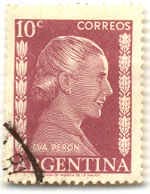
Three years before Rex Harrison and Julie Andrews bounced onto a Broadway musical stage in 1955 with My Fair Lady, a real-life Liza Doolittle had died in Buenos Aires. Like Liza, Eva Maria had started from nothing. She had been the illegitimate daughter of an illegitimate daughter in the Argentine pampas and had become Time magazine's cover story on June 23, 1947; had been called "the most important woman behind the throne" by Newsweek on Aug. 19, 1946.
By the time George Bernard Shaw's Liza had been revived on Broadway, the real-life Liza was being proposed for sainthood and was being called immortal. A quarter of a century later, Rex Harrison is again playing Professor Higgins and just down the street another cast in another show is singing its heart out about Eva Maria Ibarguren, daughter of a Basque immigrant and an Argentine woman who was part Indian. But the name of that fairy tale princess, as shown on the marquee, was not that of the waif born in Los Toldos on May 7, 1919. In bright letters it spelled out the name by which the whole world knew her: Evita!
Los Toldos (the tents) had once been an Indian camp before the Indians had been annihilated in the border wars of the 1880s. The birth and baptismal records have long since disappeared at Junin, the nearby administrative center, but their disappearance, too, has become a part of the mysteries that now swirl around the memory of the woman known to history as Eva Duarte de Peron. She, herself, created the mysteries, for there were two things Evita could never face, not even in her most intimate letters to her husband: her real age and her illegitimacy.
She always lied about her age. It was one of her many lies, lies that now shroud her in riddles that leave biographers guessing. The Broadway musical, by no means an accurate biography, cannot discern the real Evita from the one who was created purely for public consumption.
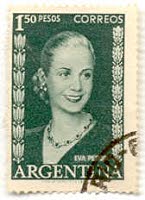 Even the image that dazzles us on the high values of the Evita stamp sets of 1952 and 1953 — a blonde beauty wearing an expensive ruby-and-diamond necklace and with her hair carefully brought together into a bun at the nape of her neck — was based on a much-retouched publicity still that was made when Evita was trying to break into the movies. One cannot tell now exactly what part was real and what came from an artist's airbrush.
Even the image that dazzles us on the high values of the Evita stamp sets of 1952 and 1953 — a blonde beauty wearing an expensive ruby-and-diamond necklace and with her hair carefully brought together into a bun at the nape of her neck — was based on a much-retouched publicity still that was made when Evita was trying to break into the movies. One cannot tell now exactly what part was real and what came from an artist's airbrush.
She never talked about her past, and no one knows with certainty just how she managed to keep body and soul together while she was an itinerant actress doing one-night stands in the provinces. Later, she became a voice in radio soap opera. In a nation where women belonged in the kitchen and were never supposed to be seen when the men retired to talk after dinner, she had two strikes against her. First she was a woman. Second she was from the wrong side of the tracks.
Peron, a widower, was the archetypical Argentine: a military officer, an expert swordsman and equestrian, a skier, a man who went around with a young girl whom he described as his "daughter." He came onto the world scene without a title, as a minor official in the military junta that had toppled Argentina's so-called democracy on June 4, 1943, installing first General Arturo Rawson and then General Pedro Ramirez as president. But a palace revolution of 1944 placed real power into the hand of a group of colonels, one of whom was Peron. Peron used his minor office in the labor ministry to advantage and from that office he built up a power base unlike any ever known in the country that had been ruled by an oligarchy of inherited wealth until the revolution of 1943.
The key event that brought him into prominence was an act of nature, an earthquake in the Andes, so remote from the centers of power that it could hardly be felt in Buenos Aires.
It had killed 6,000 people in San Juan and Peron set up a relief fund. People pushed collection boxes in front of each other and brought them to Peron. Out of a crowd of actresses stepped a radio actress whose steamy soap operas had been changed on orders of the junta to more uplifting fare, the stories of the lives of noted women. Peron described the event thus:
"A woman of fragile appearance with long blond hair falling loose to her back...said her name was Eva Duarte...and that she wanted to help the people of San Juan. I looked at her and felt overcome by her words; I was quite subdued by the force of her voice and her look."There are a few things wrong with this. It was written to become part of the mystique, not to impart truth. For at that time, Eva had black hair and she had no part in organizing the fund drive, either before or after she had spoken to Peron. In her own ghost-written autobiography, as inaccurate as Peron's, she recalled it this way:
"I was not, nor am I, anything more than a humble woman...a sparrow in an immense flock of sparrows. But Peron was, and is, a gigantic condor that flies high and sure among the summits and near to God. If it had not been for him who came down to my level and taught me to fly in another fashion, I would never have known what a condor is like."But the chance encounter of the sparrow with the condor put these two people into the same orbit, and they proceeded to use each other to rise to the top — he to the presidency, she to "immortality" (as stated on a stamp marking the second anniversary of her death).
Eva simply moved her things into Peron's apartment and evicted the "daughter." Then she began to scandalize Argentines by remaining in the room when the men started talking politics. It simply was not done in the land where the cult of masculinity thought of women only as fit objects to be seen with men when they did the sleazy dance that had made Argentina famous, the tango. Men preferred each others' company, delayed marriage, and wanted as little to do with women socially as possible. They certainly did not want them in the smoking room.
Eva not only crossed the male threshold, she even spoke! Not that she had anything of value to contribute, but she had the colossal gall to say things like "That's right!" to the horror of the men.
And what they talked about was the war and Argentine neutrality. Peron, who had seen fascism at work in Spain, Germany and Italy, had been impressed. There was no way of knowing what the Argentine people thought about the war, for nobody asked them. But the people of Buenos Aires, then the third largest city of the Americas after New York and Chicago were divided, for they had immigrated from both sides of the battle. Besides, it was good business to stay neutral and make money from both the Allies and the Axis. Not until March 1945 did Argentina make up its mind to declare war on the Axis, and then it was done under tremendous Allied pressure. Earlier, Argentina had become the pariah state of the Americas, much like Cuba today.
The declaration of war was not popular among the people who had ruled under the oligarchy. Nor was Peron when he established minimum wages for farm workers, costing the landowners money. He also required days off, medical insurance, paid holidays.
In doing these things, he made contact with people that Argentine politicians had ignored throughout history, the workers. He set up arbitration tribunals to settle labor disputes and encouraged the creation of trade unions. The oligarchs and some of the colonels targeted him for ouster. He had gone too far — not to mention the "sparrow" he dragged around with him, who was scandalizing decent people.
Peron was arrested and on that day Eva lost her lucrative lifetime contract with her radio station, which she had won after her linkup with the "condor."
But the arrest triggered something never before seen in Argentina which had often seen demonstrations in the capital by the people of the capital, often by the middle classes, well-dressed, clean, politically aware.
From the factories and farms and mines, from the harbor and the oil wells, from places most people in Buenos Aires had never heard of, came the followers. They came first in a trickle, then a stream, then a flood. They came by the millions, and they were silent. They made no demands. They just came.
Looking down from their windows, the people of means sneered "Descamisados!" It was a term of vilification, "the shirtless ones." But the silent people in the streets puzzled everyone. One newspaper editorialized: "Nobody's head was demanded." And then the people started singing a popular song with new words. The song quickly spread, and one word could be easily discerned, "Peron."
The arrest of Peron had also brought down the government and the president was trying to form a new one, the same president who had ordered Peron's arrest. To mollify the crowd, the president had Peron brought to the executive mansion and the two came out onto a balcony above the teeming mass below. They embraced, and a new song could be heard: "Tomorrow is the patron saint's day of St. Peron and then the bosses can do the work."
The next day, Oct. 17, 1945, was commemorated on a set of 1946 stamps showing "Argentina" receiving the homage of the masses, but "Argentina" is not a blonde on the stamps. The day, in fact, was marked by the closing down of every factory in Argentina, a holiday brought by the descamisados. Soon after his release from imprisonment, Peron married Eva. On the wedding certificate, she lied about her age and her name. She said she was born in 1922 and called herself Eva Duarte, making Eva Duarte three years younger than Eva Maria. And then she became a public person, going on the campaign trail with her husband on a train called "El Descamisado." She even made campaign speeches. If the oligarchs were shocked, so be it. The oligarchs painted Peron as a Nazi, fascist, demagogue thief who had stolen earthquake relief funds. In a remarkably honest election for Argentina, Peron won.
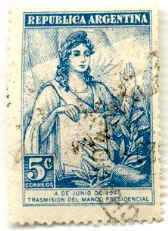 At the inauguration (for which a 1946 stamp was issued showing "Liberty" taking the presidential oath), Eva shocked the old regime even more; she wore an off-the-shoulder gown and had the temerity to stand in this revealing costume next to the primate of Argentina, Santiago Cardinal Coppello.
At the inauguration (for which a 1946 stamp was issued showing "Liberty" taking the presidential oath), Eva shocked the old regime even more; she wore an off-the-shoulder gown and had the temerity to stand in this revealing costume next to the primate of Argentina, Santiago Cardinal Coppello.
But if that was shocking, more shocks were coming. The very bastion of propriety, the Colon Opera House, soon was the scene of rallies at which Peron — in shirt sleeves! — addressed crowds who had never before been in an opera house, and next to him stood Evita, a woman among men.
Evita had arrived. She bought herself costly jewels, dresses, furs. She received presents of still more. She bleached her hair. And, modestly at first, then with ever-growing organization and ostentation, the creation of Evita's role as a saint began. At first, it was small amounts of money that she disbursed to supplicants. Soon it was hospitals, housing, schools. She built up a foundation, the Eva Peron Foundation, which had a staff and social workers. But the people still came to Evita, kneeling before her in prayerful attitudes, because Evita was known to help the needy, with charity and love, especially love. The kisses she accepted from the poor terrified her close friends, for she would not even reject the kiss of a leper or someone whose disease was discernible to all.
The foundation, however, did not disburse Evita's own funds. The funds were coerced, extorted. If you wanted to do business in Argentina, you gave. If you needed an import permit, newsprint, a government contract, you gave. If a union wanted to go on strike, it gave beforehand, to woo the officials. But so did the firm faced with the strike. The foundation was soon in business itself. The corruption was widespread, but Evita stood above it all, just dispensing love and charity as a saint should.
The richest country in Latin America could not afford all this. Nor could it afford the show put on when Evita took her triumphal trip through Europe where she was given a 21-gun salute by Fascist Spain as befitting a head of state. And had tomatoes thrown at her in Switzerland after the incident in Madrid where she had raised her hand to greet the three million Madrilenos at the airport. Unfortunately for Evita, the cameras caught her at the exact moment when her arm was up in what everyone took to be the Fascist salute.
She returned to Buenos Aires in triumph and told the descamisados for the umpteenth time of her three loves: "My country, my descamisados, and my dear General Peron."
And then Evita got sick, refusing treatment and not believing what the doctors found, cancer. She held on, making public appearances during remission, dosed with pain killers. And when she was not so well and was in the hospital her foundation had built, the descamisados kept a vigil outside, many of them on their knees, their rosary beads slipping silently through their fingers.
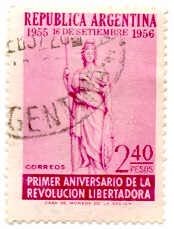 Her death on July 26, 1952, ended the saga of her life and began the new one of the holy relic of the descamisados. Peron had ordered her embalmed for eternal display. The mausoleum that was to have housed the body, however, was not finished when Peron, too, was toppled from power in 1955 (a stamp of 1955 shows "Argentina" breaking her chains).
Her death on July 26, 1952, ended the saga of her life and began the new one of the holy relic of the descamisados. Peron had ordered her embalmed for eternal display. The mausoleum that was to have housed the body, however, was not finished when Peron, too, was toppled from power in 1955 (a stamp of 1955 shows "Argentina" breaking her chains).
The cadaver became an embarrassment to the new rulers. People belonging to the cult of Evita had been praying before the building housing the body. They left flowers. The president ordered the body moved secretly. At every change of site, the flowers mysteriously appeared. The colonel who was in charge of military intelligence was given orders to hide the body once and for all.
Ultimately, he was driven mad.
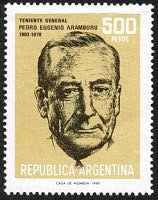 President Pedro Eugenio Aramburu, (right) denied the right to cremate the body by the Roman Catholic Church, ordered it concealed abroad and that he be informed, in writing, where it had been taken.
President Pedro Eugenio Aramburu, (right) denied the right to cremate the body by the Roman Catholic Church, ordered it concealed abroad and that he be informed, in writing, where it had been taken.
Thinking he was protecting himself, Aramburu never read the letter. He gave it to a lawyer with instructions it be given to the president of Argentina after Aramburu's death. It brought his death.
Urban guerrillas, including the Montoneros, began fighting against the post-Peron government. After Aramburu had been replaced as president, the Montoneros kidnapped him to force him to reveal where Evita's body had been hidden, something Aramburu could not do because he did not know. They killed him. When Aramburu's body was found by the police, the lawyer gave the president the letter about the hiding place of the body. Seventeen years after her death, Evita's body was exhumed in Italy, where it had rested under a false name. Even then it did not return to Argentina, being sent instead to Madrid, where Peron was in exile.
Peron returned to power in 1972 with a new wife, and she accepted the vice presidency that Evita had turned down, an act that has gone down in the Peronista holy writ as "the renunciation," another of the acts of self-abnegation that caught the public fancy, although Evita had really been too sick to take office. Thus, the third Mrs. Peron became the world's first woman president. But she never had the power of Evita, whose body Peron left in Madrid.
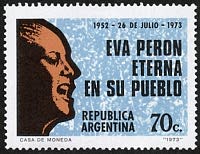 It was the Montoneros who brought Evita home. They did it by kidnapping Aramburu again, stealing his body from its crypt. In 1974, Evita's body was flown from Madrid. She lies next to Peron in an underground crypt that is thought to be secure from any future grave robbers — and also keeps the faithful from coming anywhere near it.
It was the Montoneros who brought Evita home. They did it by kidnapping Aramburu again, stealing his body from its crypt. In 1974, Evita's body was flown from Madrid. She lies next to Peron in an underground crypt that is thought to be secure from any future grave robbers — and also keeps the faithful from coming anywhere near it.
But even before Evita's body returned to Argentina, a 1973 stamp (right) marked the 21st anniversary of her death with the inscription "Eva Peron — eternally with her people." And in 1980, Aramburu, who was twice kidnapped for Evita's body, was honored with a stamp on the 10th anniversary of his death.
Stephen G. Esrati
Illustrations courtesy Ada Prill and Ron Maifield